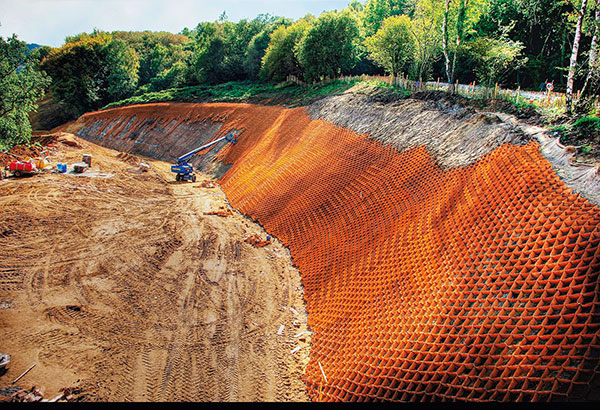





Stabilisation of Approach Cuttings for Hindhead Tunnel with DSI Soil Nails
Tunnel near Hindhead, Motorway A3, Great Britain
One of the main routes out of London is the A3, which connects London with Portsmouth. Over the years, this route has been upgraded to an efficient dual carriageway, except for one area known as the Devil’s Punchbowl in the village of Hindhead, Surrey.
The name Devil’s Punchbowl is based on the legend that the devil spent his time tormenting the god Thor by pelting him with enormous handfuls of earth, and in the process created the huge bowl in the ground that can be seen today. In reality, the large bowl was created by erosion, caused by water percolating down through the sand and hitting an impervious clay layer, causing a number of springs to rise up, which over the course of time washed away a large chunk of the overlaying sand.
Following the increase in traffic levels over the last 10 years, a solution was urgently needed to ease the congestion at the section of the single carriageway through Hindhead. The solution chosen was a 6.5km dual carriageway with a 1.8km twin bore tunnel running under the Devil’s Punchbowl.
The first phase of the project involved approach cuttings at both the North Portal and South Portal, involving large cut faces stabilised with soil nails. DSI-Systems worked closely with the designers and contractors to produce a soil nail solution consisting of DSI-Steel threadbars to stabilise the active wedge. DSI-Steel sizes varied from Ø16-28mm, depen ding on the nail loadings and their respective location on the slope face. Stability and erosion control of the facing utilised a reinforced geogrid overlaid with a multi-cellular facing to retain the top soil. DSI UK’s unique angle compensation system for the bearing plates was employed to accommodate the natural undulations across the slope face.
Work on the stabilisation of the approach cuttings started in 2007 and are set to run for four years. Initially, two drill rigs were employed by Systems Geotechnique on the North Portal works, but as work increased, up to four drill rigs could be seen working. Ground conditions are predominantly cemented sands from the Upper Hythe Beds, enabling open-hole drilling with augers. Nail lengths vary from 3m to 10m.
Further soil nailing work will follow next year as there are a number of grade separated junctions, requiring stability of the cut faces, together with additional nails required in the approach cuttings of the South Portal.
The second phase of the work, the tunnelling, has just commenced with the installation of the tube canopy at the North Portal. DSI’s AT Casing System is being used to stabilise the crown at both portals. The entrances are located in quite weak sands, where borehole stability was a concern. DSI’s AT system was able to offer the high precision demanded by the contractor, where the tolerance between arrays and installation angle were quite critical. Following initial learning curves, production is now up to an array per two shifts, as required in the program.
In total 300,000m³ of soil will be excavated during the works. This excess spoil will be utilised at the South side, where there is a significant change in levels as the road exits the tunnel bores. Once the project has been completed, the old road will be returned to a natural landscape, with special measures adopted to ensure that wildlife and plants are not affected.
